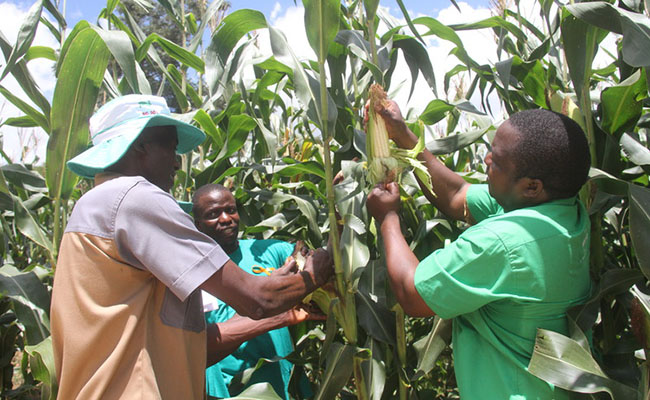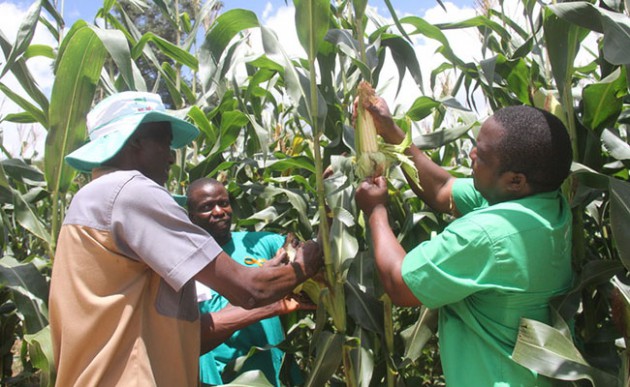Good rains, but what of tomorrow?

Sydney Kawadza Senior Features Writer
In the midst of a successful agricultural season with abundant rainfall patterns, Zimbabwe is celebrating an expected bumper harvest.
The situation is the same in most southern African countries that received favourable rainfall during the summer cropping season.
However, despite this, South African authorities are fretting over a possible long and dry summer season where water availability could be scarce.
There are genuine fears down South that the dry conditions would also affect Lesotho from where South Africa gets the bulk of its water.
It is not always a given that the El Nino weather patterns will be followed by La Nina phenomenon of good rains as is the current case.
Hirons and Klingaman (2016) writing on La Nina 2016/17 Historical Impact Analysis note that the El Niño conditions developed in the tropical Pacific during the latter half of 2015.
These peaked in December 2015 as one of the strongest El Niño events on record, comparable to the 1997-98 “El Niño of the century”.
They state that conditions in the tropical Pacific were forecast to return to normal, with the potential to transition into La Niña conditions during 2016-17.
The 2015/16 climatic conditions saw the worst drought period that affected Zimbabwe and many southern African countries.
However, the weather patterns drastically transformed leading into a wet summer season that was favourable to agricultural production.
Hirons and Klingaman further tried to explore whether all El Niño events transition into La Niña events.
“Strong La Niña conditions often, but not always, follow strong El Niño conditions.
“Between 1950 and 2015 three quarters of El Niño events were followed by La Niña conditions.
“The strongest amplitude El Niño events do not necessarily lead to the strongest amplitude La Niña events.”
An example was the strongest La Niña on record following the 1987-88 El Niño, which was only of moderate amplitude.
“Conversely, one of the strongest El Niños on record in 1987-88 led to a very weak La Niña event the following year.”
According to the South African Weather Services, La Nina is the cooling of sea-surface temperatures (SST) in the equatorial Pacific Ocean which influences atmospheric circulation, and consequently rainfall and temperature in specific areas around the world.
But what happens after La Nina?
According to the chairman of the University of Zimbabwe’s Department of Geography and Environmental Science, Professor Amon Murwira, this is not a systematic process and that is where observation becomes important.
“At the moment we can make short-term observations and here (at the UZ) our systems show us that there has been a decline in the rainfall activities.
“However, it’s much safer to assume that there might be a drought so that we can prepare using lessons from the past.”
Dr Manyewu Mutamba, writing on Climate Risks and Trends in Eastern and Southern Africa, notes that agricultural production in the region is broadly characterised by high climate risks.
“Rainfall is variable in timing, amount, and intensity. Both drought and flooding are common.
“These challenges are magnified by the fact that the majority of farmers in this region face severe poverty, resource constraints, and food insecurity.”
He said more than 90 percent of these farmers were dependent on rain-fed production.
“The rise in global greenhouse gases appears to be increasing these climate risks.”
Dr Mutamba was assessing the key findings of the Fifth Assessment Report (AR5) by the Intergovernmental Panel on Climate Change (IPCC) for Eastern and Southern Africa.
The report indicates that temperatures in much of Sub-Saharan Africa are rising faster than in other parts of the world.
“In most of ESA temperatures have already increased by 0,5-1 degree centigrade over the past 50 years. The largest gains have occurred in average minimum temperatures.
“Large inter- and intra-annual rainfall variability is already a major challenge for agricultural production in many parts of ESA.”
He says the combination of higher temperatures and variable rainfall may be contributing to rising pest and disease pressures.
Dr Mutamba notes that in the near term, the adoption of agricultural technologies, production levels, and food security will be affected more by rising population pressures and changing market conditions than by changes in climate.
“However, given the high costs of droughts and flooding, higher priority needs to be attached to the promotion of climate smart practices that improve resilience to these risks,” he said.
The prospect of continuing increases in temperature suggests the importance of investments in crop varieties that are more temperature – and drought-tolerant, and field management strategies that reduce evaporation.
Zimbabwe last week commemorated World Water Day under the theme: Why waste water?
The theme is in support of Sustainable Development Goal 6.3 on improving water quality and reducing, treating and reusing wastewater.
UNICEF in Zimbabwe said the issue of water availability has been a paradox between excess water and too little water available.
“During the 2015 /2016 rainy season the country suffered a crippling drought which came after successive years of poor and inadequate rainfall.
“In contrast, the following 2016 /2017 rainy season was a complete opposite which saw above normal rainfall which led to widespread flooding in parts of the country.
“Either way the challenge faced by many communities and especially children is that of access to safe water, sanitation and hygiene.”
The successive droughts, the UN agency said, led to many water sources drying up across the country.
“In areas with piped water such as many towns and growth points, taps ran dry as water rationing was instituted.
“In areas without piped water many of the available water sources ran dry such as boreholes, wells, rivers and dams. This meant communities had to go farther to find water.”
The 2016 /2017 rainy season saw much damage wrought to key infrastructure such as roads, bridges, schools and clinics.
“The other challenge posed by the excessive rainfall is the high risk of contamination of the available water sources as both latrines and water sources are flooded.
“This further exacerbates the challenges of access to safe water, sanitation and hygiene.”
UNICEF called on Government to plan for and mitigate against extreme weather patterns.
In noting the challenges, Environment, Water and Climate Minister Oppah Muchinguri-Kashiri said Government would construct weirs in all 10 provinces.
This is part of Government’s Command Rain Water Harvesting Programme aimed at harnessing water from floods and excessive rains.
She said while Zimbabwe lamented losses recorded during flooding, the climate change variability has presented an opportunity for a paradigm shift in water resources planning, development and management programmes.
The abundant rains should be an answer to the country`s water problems, according to experts.
Mr Andrew Mushita, the executive director of the Community Technology Development Trust, said Zimbabwe and the region need to take advantage of the rains that fell during the season.
“The Sadc region needs to develop infrastructure to harness water for irrigation development with the objective of improving livelihoods, poverty alleviation, economic strengthening and supporting disadvantaged communities,” he said.
Sadc member countries should share meteorological and hydrological data and information, disaster risk reduction strategies and agricultural technologies essential for adaptation and adoption by farmers in times of increased rainfall in order to enhance food productivity.
“As a result there is need to intensify establishment of irrigation schemes as irrigated agriculture presents an attractive alternative under these conditions for increased food productivity,” he said.
“The opportunity reduces or removes water deficit as a limiting factor in plant growth and makes it possible to grow crops during the winter period or year round.”
He said there were possibilities of facilitating irrigation schemes through the abstraction of water from the sources and conveying it to the fields.
“Irrigation in southern Africa region is largely fragmented by nature except in parts of South Africa and Zimbabwe,” he said.
The southern African region has a total area of 6,9 million square kilometres of which 1,5 million square kilometres is cultivable.
The actual cultivable areas are 349 747 square kilometres and the irrigated areas are only 5.2 percent of that (18 272 square kilometres).
Mr Mushita said a fraction of the dam water capacity is used for irrigation purposes while most of it is primarily used for hydropower generation.
Sadc countries need to develop a strategy to coordinate the uptake, consumption, and use of water from river basins by establishing agricultural irrigation systems in all the water catchment areas.
“The challenge is to make domestic production keep pace with the growth of demand for food, and ensure agricultural productivity is not adversely affected by climate change and water shortages.
“Secondly, the countries need to share information from line ministries that relate to; agricultural practices and extension messages, environmental impact, science, agricultural technologies and natural resource management.
“Once this information and data is collected from the various ministries this can be shared by farmers to enhance their choice of crop varieties they can cultivate.”
Mr Mushita said climate change was now unequivocal, particularly in terms of increasing temperatures, increasing CO2 concentration and rising global average sea level.
He said the region should develop a strategy for harnessing water to facilitate its use during the dry season through irrigation.
“This could be an alternative solution to reduce the negative impact on agricultural production due to excessive rainfall and flooding which is affecting agricultural production especially in sandy soils this season.”
The promotion of dry season irrigation where the water table is high is a viable solution to increased food and nutrition security.
Feedback: [email protected]










Comments